Are you new to fish keeping and wondering what to look for when testing your aquarium’s water for ammonia, nitrite, and nitrate?
Keep scrolling to find out!
The safest ammonia and nitrite levels in an aquarium are 0 ppm or an amount that is too small to be detected by water tests. Nitrate levels are safe for most aquatic pets at 0-40 ppm. Nitrate levels above 40 ppm become risky, and above 80, they can become dangerous.
High ammonia, nitrite, and nitrate levels can kill your fish. Please continue reading to learn how to check and lower them.
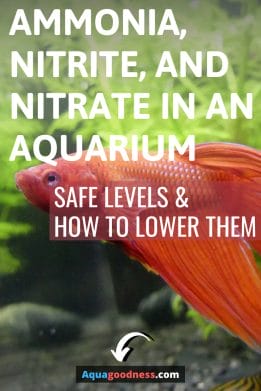
Table of Contents
What Are Safe Ammonia, Nitrite, And Nitrate Levels In An Aquarium?
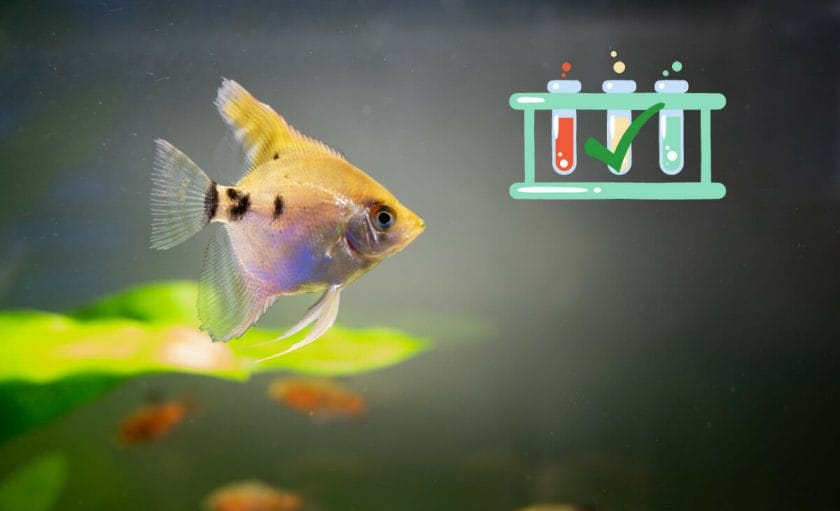
Ammonia, nitrites, and nitrates are toxic chemicals that occur naturally in all healthy aquariums. There are a few regular maintenance tasks, which I will cover more later, that fish keepers do to keep these levels low.
However, sometimes these harmful chemicals can concentrate and become dangerous to our fish. That’s why you need to know when the levels are too high.
Ammonia levels should read 0 ppm (parts per million) on a water test.
Not only are higher levels of ammonia bad for your fish, but it also signals a filtration problem in your aquarium.
If this is the case, many other harmful things probably aren’t being filtered out properly either, and you need to solve the problem asap.
Nitrite levels should always read 0 ppm on a water test.
Depending on what type of fish you have, nitrites are extremely poisonous. To certain fish, less than 1 ppm can be deadly.
This is why it’s especially important to keep nitrite levels down.
Again, higher levels of nitrites means your tank isn’t filtering properly, and you’ll need to do something to remedy this fast.
I’ll go into more detail about how to fix this later in the article.
Nitrate levels should be below 40 ppm.
People tend to be confused about nitrate levels and where they should be. Generally, you should try to keep levels as low as possible.
Even though levels below 40 ppm won’t kill fish, that doesn’t mean it doesn’t cause stress to them. Yes, they can withstand these levels and be safe and healthy, but lower levels are always better for them.
However, you also have to consider the needs of your live plants. Live plants need nitrates to survive, so keep this in mind when deciding the best nitrate level for your aquarium.
Another thing to keep in mind is that these levels don’t apply to brand-new tanks.
In the first few weeks of running a new tank, chemical levels will be all over the place. This is normal, and it will eventually regulate itself if properly filtered.
What Contributes To Ammonia, Nitrite, And Nitrate Levels In An Aquarium?
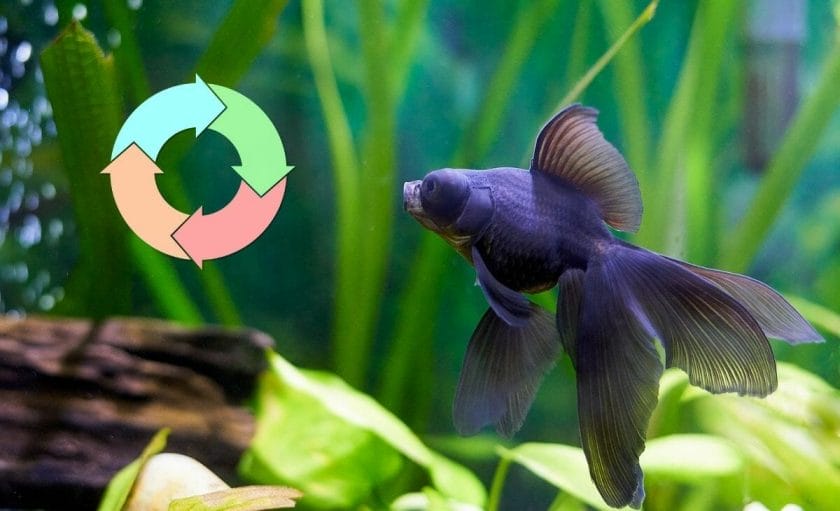
Ammonia, nitrite, and nitrate are naturally produced in any aquarium. To better understand where they come from, you need to understand the nitrogen cycle.
The Nitrogen Cycle
- Waste
Once your fish produces waste, it releases ammonia as it decays. But fish waste isn’t the only ammonia-producing waste in an aquarium.
Dying plants, uneaten fish food, and dirty filters all contribute to ammonia production within your tank. Fish also excrete ammonia when they breathe.
Anything alive that dies or decays is going to produce ammonia.
- A New Bacteria Begins To Form Inside Your Aquarium
Bacteria known as Nitrosomonas form inside your tank as ammonia levels increase.
Ammonia is their main source of food. That’s why this bacteria only start to form once enough ammonia has accumulated for it to feed on.
This bacteria can eat ammonia as fast as it’s produced.
Ammonia levels will be higher in a new tank, and you have to give it time to form the necessary bacteria to reduce ammonia levels.
If your tank isn’t new, it likely already contains this bacteria.
- Ammonia Is Turned Into Nitrites
When the bacteria (Nitrosomonas) feed on ammonia, they produce nitrites. This is when ammonia levels lower, and nitrite levels rise.
- Another Bacteria Starts To Form
Once a good amount of nitrites are present in your aquarium, another bacteria will move in. This bacteria is known as Nitrobacter.
This bacteria can eat nitrites as fast as they are produced.
In new tanks, it takes time for Nitrobacter to form as they need enough nitrites to be available. This is why nitrite levels are higher in the beginning.
An established tank will already have this bacteria formed.
- Nitrites Are Turned Into Nitrates
Once this bacteria feeds on the nitrites inside your tank, it produces nitrates. At this point, nitrite levels lower, and nitrate levels rise.
Nitrates are much less harmful to fish than ammonia and nitrites, but they still pose a threat. Keeping nitrates down is important for the safety of your fish.
Unfortunately, there are no nitrate-eating bacteria coming to save the day this time. If any bacteria does feed on it, it won’t do much to affect overall nitrate levels.
Reducing the nitrate levels in your aquarium relies solely on you and how well you maintain your tank. Water changes are the best way to reduce nitrates.
How To Test Your Aquarium’s Water (Step-By-Step Instructions)
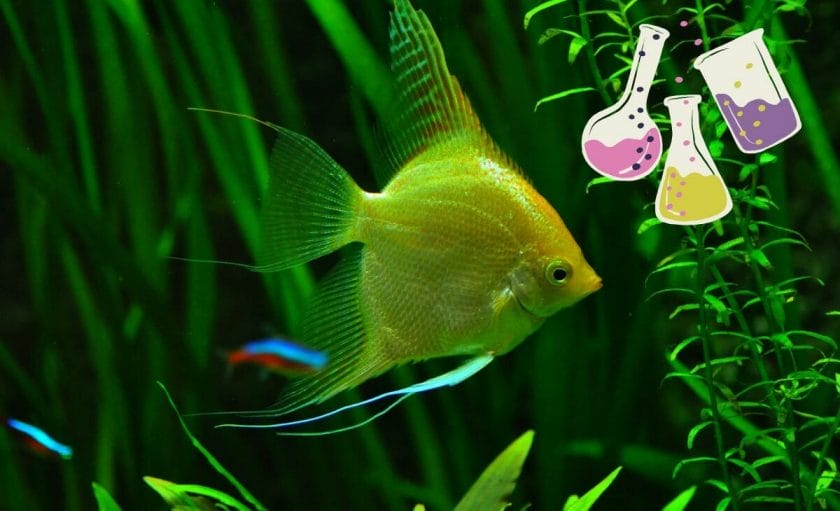
I know how confusing it can be when trying to test your tank water for the first time. There are so many different tests and ways out there and you’re not sure what to do.
That’s why below I’ve given step-by-step instructions on how to test your aquarium’s water using the API Test Kits for ammonia, nitrites, and nitrates.
How To Test For Ammonia
- Fill the test tube with 5 ml of your tank’s water or to the fill line.
- Add 8 drops from the Ammonia Test Solution Bottle #1, and hold the dropper bottle upside down in a vertical position to ensure the drops are uniform.
- Add 8 drops from the Ammonia Test Solution Bottle #2, and hold the dropper bottle upside down in a vertical position to ensure uniform drops as in the step above.
- Cap the test tube and shake vigorously for 5 seconds.
- Now wait 5 minutes for the color to develop.
- After 5 minutes, compare the color of the solution to the appropriate Ammonia Color Card (choose either Freshwater or Saltwater. For ponds, use the freshwater color card). The closest match indicates the ppm of ammonia in the water sample. Rinse the test tube with clean water after use.
How To Test For Nitrites
- Fill the test tube with 5 ml of your tank’s water or to the fill line.
- Then add 5 drops of the Nitrite Test Solution, and hold the dropper bottle upside down in a vertical position to ensure the drops are uniform.
- Cap the test tube and shake it for 5 seconds.
- Now wait 5 minutes for the color to develop.
- After 5 minutes, compare the color of the solution to the color of the nitrite color card. The closest match indicates the ppm of nitrites in the water sample. Rinse the test tube with clean water after use.
How To Test For Nitrates
- Fill the test tube with 5 ml of your tank’s water or to the fill line.
- Then add 10 drops from the Nitrate Test Solution #1, and hold the dropper bottle upside down in a vertical position to ensure the drops are uniform.
- Cap the test tube and invert the tube several times to mix the solution.
- Vigorously shake the Nitrate Test Solution #2 for at least 30 seconds. This step is very important for accurate results.
- Now add 10 drops from the Nitrate Test Solution #2, and hold the dropper bottle upside down in a vertical position to ensure the drops are uniform as in step #2.
- Cap the test tube and shake vigorously for 1 minute. This step is also very important for accurate results.
- Now wait 5 minutes for the color to develop.
- After 5 minutes, compare the color of the solution to the appropriate nitrate color card (choose either freshwater or saltwater). The closest match indicates the ppm of nitrates in the water sample. Rinse the test tube with clean water after use.
What To Do If The Chemicals In Your Aquarium Reach Toxic Levels

If you test your water and discover that your ammonia, nitrite, or nitrate levels are too high-you’ve got some work to do.
Do a Partial Water Change
The first thing to do is a water change of at least 25-50%. If you replace 50% of the water with clean water, you just removed 50% of the toxic chemicals that were in the tank.
While you do a water change, you should also clean the sides of the tank to remove any buildup.
Add Water Conditioners
If your ammonia, nitrite, or nitrate levels are too high, you can add water conditioner to your aquarium. They make certain water conditioners that remove ammonia and/or nitrates such as Seachem Prime.
Some of them just detoxify them but don’t remove them, allowing the bacteria in your tank to destroy them.
Add Bacteria-boosting Products
Another thing to do that helps is adding bacteria-boosting products to your filter. The bacteria that usually eliminates ammonia and nitrates may be lacking in your tank, which could’ve been the cause of their high levels.
You can add products that boost those bacteria in your filter, which will allow them to feed on the extra ammonia and nitrites in your aquarium.
Use A Cycled Filter
If the bacteria in your tank is running low (and it probably is), you could add a cycled filter to your tank. A cycled filter is a filter that’s already undergone the nitrogen process in another fish tank.
It means it already contains all the necessary bacteria for breaking down ammonia and nitrites.
Of course, this may only be possible if you have a second tank or know someone who would let you use one of theirs.
Tips To Keep Ammonia, Nitrite, And Nitrate Levels In Your Aquarium Low
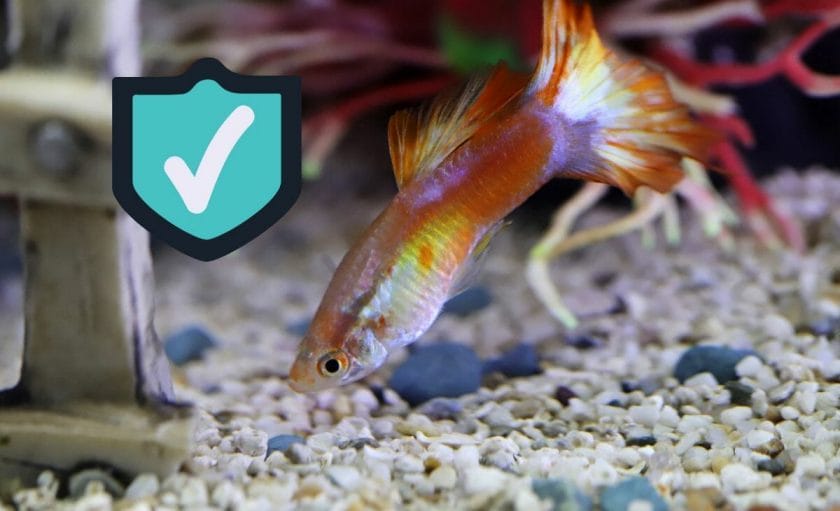
Here are some helpful tips to ensure your tank remains as safe as possible for your fish.
Do Water Changes Regularly
Changing your tank’s water regularly is very important to keep the toxic chemicals in your tank from building up.
You should change 25% of your aquarium’s water at least once a week for optimal water quality. The amount of water and frequency depends on how quickly nitrate builds up in your tank.
Following the below tips could allow you to change less water less frequently.
Do Not Overcrowd Your Tank
In other words, don’t put too many fish into one tank. There shouldn’t be more than 3 fish in a 2-gallon tank or more than 6 fish in a 5-gallon.
Now, this depends on how big your fish are as well. Basically, make sure your fish have plenty of room to move around and that the size of your tank can handle the amount of waste product your fish will produce in it.
As the waste product is what turns into ammonia, nitrites, and nitrates.
Keep Up With Cleaning
This refers to scrubbing the walls of the tank, vacuuming the gravel at the bottom, and cleaning any decorations or objects in the tank.
If you have live plants, get rid of decaying or dead pieces as soon as you notice them.
For more information on how often and how to clean your fish tank, read this article.
Keep Strict Feeding Plans
When leftover food sits at the bottom of the tank, it produces ammonia. This won’t solve all your problems, but it can definitely help to regulate how much you’re feeding your fish.
Only feed them what they’ll eat in one minute, no left overs.
Keeping this on a tight schedule can help you keep track of how much food your fish eats each day.
Get Some Live Plants
Live plants add many benefits to an aquarium.
The most important being that they remove ammonia, nitrates, and carbon dioxide along with other harmful things from your aquarium.
Another added benefit is that they can reduce stress levels in your fish.
They mimic a fish’s natural habitat and can even help them be less aggressive.
Welcome A Clean-Up Crew
To keep the ammonia, nitrite, and nitrate levels low in your tank, you’ll need to keep it clean. This means removing any uneaten food from your tank because if you keep uneaten food in the tank, it’ll produce ammonia in the tank.
Now you could remove the uneaten food from the tank using a fish net and you should do it.
Besides, there are a number of aquatic pets you can add to your tank that can eat the leftovers from your tank, helping you to keep your tank clean.
And most of them are perfectly safe to add in with your fish.
However, it’s always safer to do your own research before you add a new addition to your tank, though. Every fish is different and will interact differently with other creatures.
Here are some species that provide superb cleaning services:
- Amano Shrimp
- Plecos
- Platies
- Flagfish
- Loaches
- Snails
- Corydoras
- South American Cichlids
- Redtail Sharks
- Rainbow Sharks
What Can High Ammonia, Nitrite, Or Nitrate Levels Do To Your Fish?
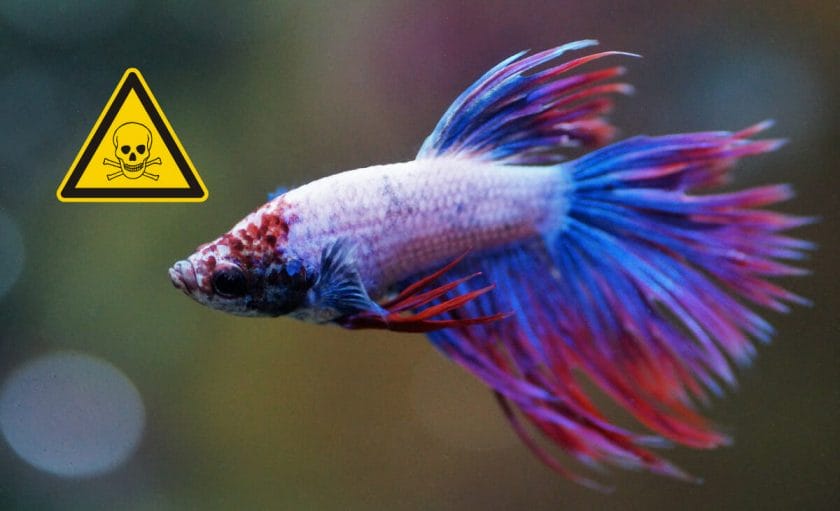
High levels of these chemicals will poison your fish.
You’ll notice odd behaviors such as erratic swimming, gasping, lethargy, twitching, flicking, rubbing, or hovering at the surface.
You may notice discoloration of varying degrees, and they may have trouble eating.
These are all signs that your fish are experiencing ammonia, nitrite, or nitrate poisoning and you must act quickly.
Fish can die within a few minutes of experiencing these symptoms.
How To Treat Fish With Poisoning
- Water Change
The first thing to do when you notice these symptoms is to complete a water change.
Make sure you replace the water with clean, treated water. Use a water conditioner if needed. Remove any noticeable build-up in the tank.
- Introduce Good Bacteria
Add products that will introduce the good bacteria needed to remove these toxins into your tank.
The more of these bacteria in your tank, the more ammonia and nitrites they consume.
Follow the product instructions to know how much to add.
- Add Chemical Filtration
Add substances like zeolite or activated charcoal to help filter out the harmful chemicals.
Follow the product instructions to know how much to add.
- Use Ammonia-Binding Chemicals
You can add certain chemicals to your tank that will bind the ammonia and make it nontoxic. It will still be present, just not harmful to your fish.
This is only temporary though, you still need to remove it.
Follow the product instructions to know how much to add.
- Place Some Air Stones
Placing air stones inside your aquarium can help reduce the chances of your fish suffocating by providing more oxygen.
- Add Some Salt
Introducing 1-2 grams of salt per 1 liter of water can help to alleviate the stress on the kidneys of your fish.
- Hold Off On Feeding Your Fish
Try to avoid feeding your fish when they have this type of poisoning or when ammonia, nitrite, or nitrate levels in your tank are dangerously high.
Food not only comes out as waste and creates more ammonia, but it also causes the fish to produce more ammonia from breathing.
If your fish are really sick, chances are they won’t be able to eat properly anyway, and eating can cause extra stress on their bodies.
- Transfer Them If Needed
This is the last resort. If the symptoms persist after completing all of the above steps and don’t seem to be getting any better, you may need to put your fish into a different container.
Preferably another tank with clean, treated water with a filter.
Keep the fish as healthy as possible using the above methods until your original tank’s ammonia, nitrite, and nitrate levels have gone back to a safe level.
- Continue Testing
Test the water every day to make sure levels are lowering as they should be.
FAQ
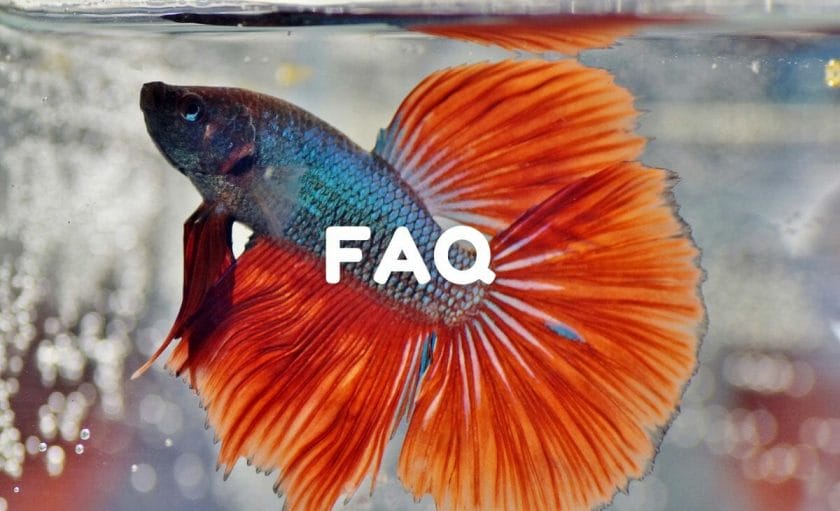
Will 1 ppm Of Ammonia Kill Fish?
Yes, 1 ppm of ammonia can kill fish. Certain hardy fish might be able to withstand it, but they won’t thrive.
The kind of fish you have is what determines how fast or slow it will happen.
Should Ammonia, Nitrite, And Nitrate Levels In A Freshwater Aquarium Be Different From A Saltwater Aquarium?
No. Ammonia, nitrite, and nitrate are toxic to all kinds of fish in any kind of aquarium. Ammonia and nitrite levels should still be at 0 ppm or undetectable in a saltwater tank.
Nitrate levels should stay below 40 ppm.
Conclusion
Ammonia, nitrite, and nitrate are naturally occurring harmful toxins that build up in aquariums.
They are extremely harmful to fish and can even lead to death, so make sure to follow the provided tips to keep levels low and safe.